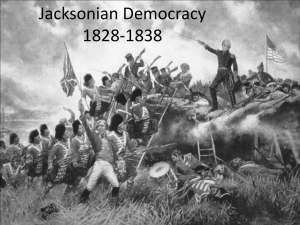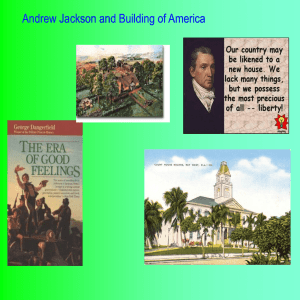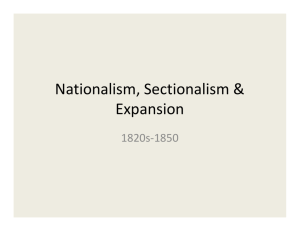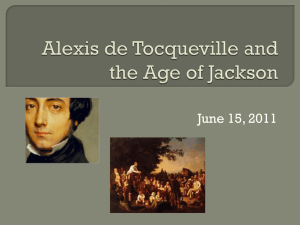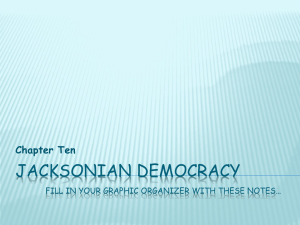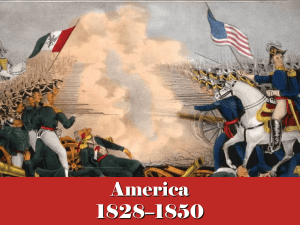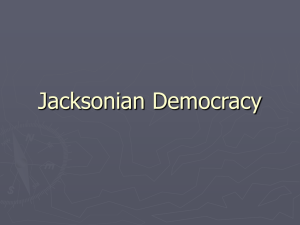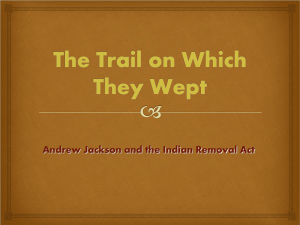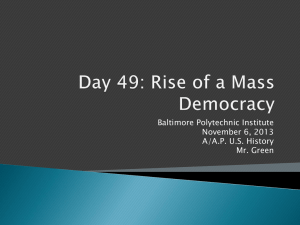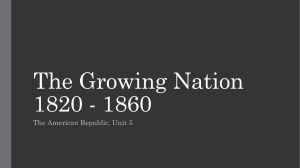File
advertisement
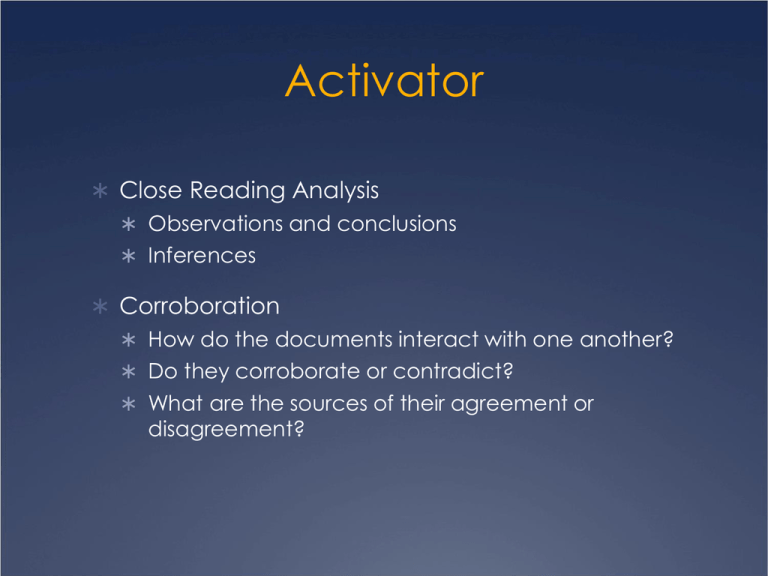
Activator Close Reading Analysis Observations and conclusions Inferences Corroboration How do the documents interact with one another? Do they corroborate or contradict? What are the sources of their agreement or disagreement? Observations and conclusions; Inferences Lithograph by Edward Williams Clay, 1834 Observations and conclusions; Inferences Corroboration Corroboration How do the documents interact with one another? Do they corroborate or contradict? What are the sources of their agreement or disagreement? The Age of Jackson The Jacksonian Period (1824-1848) has been celebrated as the era of the “common man.” Thinking about economic development, politics, and social reform movements, to what extent did this period live up to its characterization? Homework Tonight (11/18) Watch Age of Jackson: Crash Course in American History #14 Tonight (11/18) Review Chapter 13 Cornell Notes, Age of Jackson Lecture Notes (and corresponding Adam Norris video) Tomorrow: Complete the APUSH Review: Chapters 11-13 (first without notes; then look back) Looking ahead: Read Chapter 14 (due Thursday 11/21) and 15 (due Monday 11/25) Not requiring Cornell Notes B for these chapters, but you will be accountable for them through online quizzes and your period 4 test. Period 4 test Tuesday - Wednesday the 26-27th FRQ and Multiple Choice The “Corrupt Bargain” Election of 1824 4 candidates for President: Andrew Jackson (TN), John Q. Adams (MA), Henry Clay (KY), George Crawford (GA) None win majority of electoral vote Per 12th amendment (1804), House votes on top 3 Clay out Clay (Speaker of the House) throws support behind Adams Adams wins (#6); Clay becomes Secretary of State Jackson, who won majority of popular vote, is furious Democratic participation “Old Hickory” Was seen as a “common man” Strong unionist & nationalist, believed in federal supremacy over the states “Spoils” System: giving government jobs in exchange for political support Believed the more people in office, the more government is truly by the people Tariff of Abominations (black tariff) (1828) Tariffs, especially this one, promote sectional differences South Carolina proposed that the state should nullify the tariff Fear over federal interference with slavery; Denmark Vesey’s rebellion (1822) VP John C. Calhoun secretly penned the South Carolina Exposition Connection: Where does the logic of nullification come from? “Nullies” in South Carolina Tariff of 1832 South Carolina legislature nullifies tariff Reduced the tariff amount, but still high enough to anger the South Threatened to secede from the union if federal government tries to collect duties by force (Nullification Crises) Jackson dispatched naval, mulitary reinforcements; quietly mobilized army Henry Clay resolved the issue: Compromise Tariff of 1833 Tariff would be reduced by 10% per year for 8 years Prevents a Civil War Force Bill, “Bloody” Bill (1833) President can use the military to collect federal tariffs “Civilizing” the Native Americans Washington acknowledges Indians as independent nation Treaties are constantly violated; territorial lines redrawn to the loss of Native Americans Assimilation 1787 Society for Propagating the Gospel Among Indians 1793 Congress appropriated $20,000 for promotion of literacy, agriculture, vocational instruction Southern tribes, “Civilized Tribes,” accommodated Cherokee Alphabet, written legal code, written constitution, cotton plantation and slaveholding (1,300), newspaper, dress The Trail of Tears Indian Removal Act (1830) Removal of Native Americans beyond the Mississippi to Oklahoma “Trail of Tears” 1831-38 1831 Choctaw – 1832 Seminole – 1833 Creek – 1837 Chicasaw – 1838 Cherokee 1838 18,000 Cherokees forcibly removed from their homes and marched 1,000 miles to Indian Territory (Oklahoma) Cherokee Nation v. Georgia (1831) Court ruled that the Cherokee nation was not a foreign nation with the right to sue Federal Court Worcester v. Georgia (1832) Rules that the law of Georgia had no force within the boundaries of the Cherokee land and the Cherokee could not be required to move west Jackson ignores, (allegedly says) “John Marshall made his decision, now let him enforce it.” The Trail of Tears (1831 – 1838) The Bank War Jackson hated BUS, distrusted monopolies and big businesses Clay (KY) and Webster (MA) pushed for new charter in 1832, four years before 2nd charter expired Jackson used veto Connection: Supreme Court declared BUS2 constitutional in which case? Clay dubs Jackson King Andrew the First, forms Whigs 1833, Jackson decides to “bury” the bank by removing federal funds Nicholas Biddle, president of the BUS, is forced to recall loans creates economic “panic” BUS is dead due to lack of funds (with four years left) 1836, w/economy spiraling out of control, Jackson calls Specie Circular: No more speculation on credit: All public lands must by purchased with “hard” currency (gold) Helps contribute to panic and crash in 1837 Panic of 1837 What caused Panic of 1837? Speculation of western land (buy low, sell for profit) Bank War Specie Circular, shortage of gold “Pet” Banks: State banks in which the federal gov. deposited funds after the death of BUS A way of showing patronage (spoils) Texas NOT yet part of the United States 1823, a newly independent Mexico granted to Stephen Austin what is today Texas: Mexico encourages immigration of Catholics 1830, Mexico emancipated slaves, tensions between Mexico and the US increased Texas declares independence from Mexico in 1836 Sam Houston named commander-in-chief Santa Anna (leader of Mexico) sends 6,000 troops into Texas (Remember) The Alamo: 13-day siege, all Americans are killed Battle of San Jacinto: Sam Houston captures Santa Anna, signs 2 treaties: Withdraws Mexican troops, recognizes boundary of Texas (will come into play in Mexican-American War!) Later Santa Anna will claim he signed under duress, treaties null and void Texas wants to join Union Fear from North over slavery Jackson recognizes Republic of Texas on Jackson’s last day in office Still, NOT part of the United States “Age of Jackson” Legacy Jackson elected via a more democratic process and yet he concentrated more power in the executive, in a thoroughly undemocratic way. Disastrous fiscal policies; initiated large-scale Indian Removal Argued that the president is most important democratically elected official in the country Expansion of democracy Important caveat: Women, blacks, Native Americans denied the vote The beginnings of the modern American political system Whigs (Northern, business) vs. Democrats (Southern, agrarianslavery)
